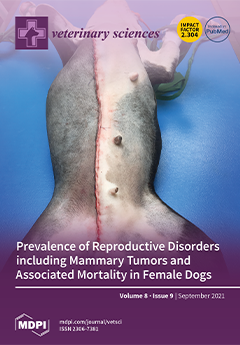Some enteric parasites causing zoonotic diseases in livestock have been poorly studied or even neglected. This is the case in stramenopile
Blastocystis sp. and the microsporidia
Enterocytozoon bieneusi in Spain. This transversal molecular epidemiological survey aims to estimate the prevalence and molecular diversity of
Blastocystis sp. and
E. bieneusi in cattle faecal samples (
n = 336) in the province of Álava, Northern Spain. Initial detection of
Blastocystis and
E. bieneusi was carried out by polymerase chain reaction (PCR) and Sanger sequencing of the small subunit (
ssu) rRNA gene and internal transcribed spacer (ITS) region, respectively. Intra-host
Blastocystis subtype diversity was further investigated by next generation amplicon sequencing (NGS) of the
ssu rRNA gene in those samples that tested positive by conventional PCR. Amplicons compatible with
Blastocystis sp. and
E. bieneusi were observed in 32.1% (108/336, 95% CI: 27.2–37.4%) and 0.6% (2/336, 95% CI: 0.0–1.4%) of the cattle faecal samples examined, respectively. Sanger sequencing produced ambiguous/unreadable sequence data for most of the
Blastocystis isolates sequenced. NGS allowed the identification of 10
Blastocystis subtypes including ST1, ST3, ST5, ST10, ST14, ST21, ST23, ST24, ST25, and ST26. All
Blastocystis-positive isolates involved mixed infections of 2–8 STs in a total of 31 different combinations. The two
E. bieneusi sequences were confirmed as potentially zoonotic genotype BEB4. Our data demonstrate that
Blastocystis mixed subtype infections are extremely frequent in cattle in the study area. NGS was particularly suited to discern underrepresented subtypes or mixed subtype infections that were undetectable or unreadable by Sanger sequencing. The presence of zoonotic
Blastocystis ST1, ST3, and ST5, and
E. bieneusi BEB4 suggest cross-species transmission and a potential risk of human infection/colonization.
Full article






